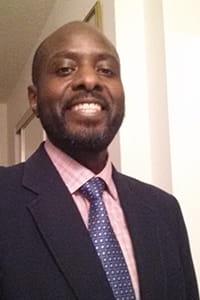The Challenge: Diagnosing Scleroderma
In 2008, 33-year-old Ronald Prescott felt winded during routine activities. The active husband and father shrugged it off, hoping the problem would go away.
Soon after, he couldn’t participate in sports or other activities without struggling to breathe and keep up. He credited this to being overweight and vowed to exercise more regularly.
But when he developed a loud, phlegm-producing cough deep in his chest, the Maryland resident couldn’t ignore his problem any longer and finally went to the doctor. This marked the start of Ronald’s long journey in search of a diagnosis and effective, lasting treatment.
Ronald spent years going to different doctors and never received a firm diagnosis. Doctors prescribed him medicine to improve his breathing, but it only worked temporarily.
Finally, a specialist provided Ronald with was a diagnosis: organ-involved scleroderma. Scleroderma is an autoimmune disease that damages skin and other tissues, sometimes causing scarring of the lungs.
Although Ronald had trouble breathing, he stayed as active as he could. He walked on the treadmill, ran errands, and attended his kids’ basketball games. But the scleroderma continued to take its toll. It caused pulmonary hypertension, or high blood pressure in the arteries to his lungs, and pulmonary fibrosis, a degenerative lung condition.
Ronald was dependent on an oxygen tank that limited his activities and his mobility around his own house.
“It hurt me that I couldn’t keep up with my family. I couldn’t have fun. I couldn’t do the things that I used to just casually do,” Ronald says. “If I got a cold, I was down for weeks. But I couldn’t afford to let depression set in.”
Ronald found a pulmonologist (lung doctor) who better understood his condition. The doctor treated him for several years and helped him fight the decline of his lungs. But after a complex operation failed to improve blood flow to Ronald's lungs, the doctor told him he was nearly out of options. It was time for a lung transplant — a prospect that terrified Ronald.
The Path to a Double Lung Transplant at UPMC
Because of his complicated diagnosis, Ronald had trouble finding a hospital that would accept him into their transplant program. When a local center turned him away, and after pursuing a few others, Ronald found UPMC.
The UPMC lung transplant team told him he was a good candidate for lung transplant. But going through with the surgery scared Ronald. A lung transplant had only two possible outcomes: success or failure.
After struggling over the decision, Ronald eventually felt he was ready for the transplant and a shot at a normal life.
In July 2016 — nearly eight years after his symptoms began — Ronald got the call from UPMC. They told him a pair of donor lungs were ready for him. Ronald underwent a double lung transplant and was out of bed and walking around just 10 days later.
Throughout his preparation, surgery, and recovery, Ronald had a tremendously positive experience with the entire lung transplant team and staff at UPMC Presbyterian — from his surgeons to those who prepared his meals. He describes his doctors as compassionate and thorough, taking as much time as needed to explain procedures and conditions. The people he met also gave him a sense of belonging.
“Everybody made me feel like I was the top priority, and that they really cared,” Ronald says. “Even the people in the reception area — they don’t just say, ‘How can I help you?' They tell me I’m looking good and ask me where my wife is. When I go to UPMC, I’m back home.”
The Results: Back to a Full Life
Ronald has come a long way since his double lung transplant surgery. He coaches his son’s basketball team and can run and shoot hoops with the players. He can walk miles at a time, even in the heat of summer.
Ronald says his pre-transplant coordinator — whose official work was complete after his surgery — exemplified the level of care he received at UPMC. The coordinator still came to see Ronald at every one of his nine follow-up appointments the year after his transplant surgery.
“You just can’t take that for granted. That’s priceless, and it’s just one example of what UPMC means to me,” Ronald says.
After years of conversations with other doctors, Ronald thought there was no chance he could fight his lung condition and survive. But going to UPMC gave him the hope for a future he’d thought was impossible.
Thanks to his lung transplant, the hobbies Ronald missed out on for eight years are now part of his life again. He's back to living a full life of fishing, dancing, cooking, and taking care of his wife and kids.
Ronald's treatment and results may not be representative of similar cases.
Learn More About Lung Transplant
UPMC Transplant Services
UPMC HealthBeat Blog



















